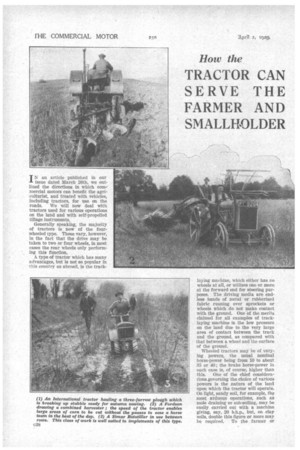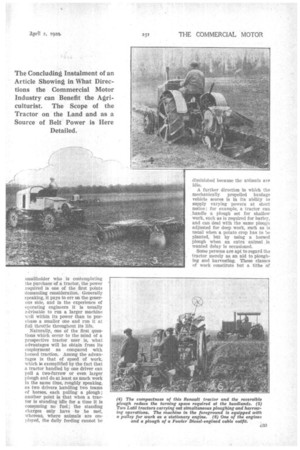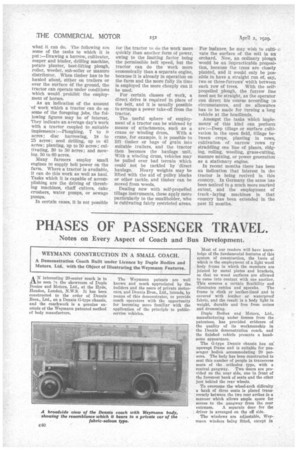How the
Page 60

Page 61

Page 62

If you've noticed an error in this article please click here to report it so we can fix it.
TRACTOR CAN SERVE THE FARMER AND SMALLHOLDER
IN an article published in our issue dated March 26th, we outlined the directions in which corn-. mercial motors can benefit the agriculturist, and treated with vehicles, including tractors, for use on the roads. We will now deal with tractors used for various operations on the land and with self-propelled tillage instruments.
Generally speaking, the majority of tractors is now of the fourwheeled type. These vary, however, in the fact that the drive may be taken to two or four wheels, in most cases the rear wheels only performing this function.
A. type of tractor which has many advantages, but is not so popular in this country as abroad, is the track laying machine, which either has no wheels at all, or utilizes one or more at the forward end for steering purposes. The driving media are endless bands of metal or rubberized fabric running over sprockets or wheels which do not make contact with the ground. One of the merits claimed for all examples of tracklaying machine is the low pressure on the land due to the very large area of contact between the track and the ground, as compared with that between a wheel and the surface of the ground.
Wheeled tractors may be of varying powers, the usual nominal horse-power being from 10 to about 35 or 40; the brake horse-power hit each case is, of course, higher than this. One of the chief considerationsgoverning the choice of various powers is the nature of the land upon which the tractor will operate. On light, sandy soil, for example, the most arduous operations, such as mole draining or sub-soiling, may be easily carried out with a machine giving, say, 20 b.h.p., but, on clay soils, double this figureor more may be required. To the farmer or
smallholder who is contemplating the purchase of a tractor, the power required is one of the first points demanding consideration. Generally speaking, it pays to err on the generous side, and in the experience of operating engineers it is usually advisable to run a larger machine well within its power than to purchase a smaller one and run it at full throttle throughout its life.
Naturally, one of the first questions which occur to the mind of a prospective tractor user is, what advantages will he obtain from its employment as compared with horsed traction. Among the advantages is that of speed of work, which is exemplified by the fact that a tractor handled by one driver can pull a two-furrow or even larger plough and do at least as much work in the same time, roughly speaking, as two drivers handling two teams of horses, each pulling a plough ; another point is that when a tractor is standing idle for a time it is consuming no fuel; the standing charges only have to be met, whereas, where animals are employed, the daily feeding cannot be diminished because the animals are. idle.
A further direction in which the mechanically propelled haulage vehicle scores is in its ability to supply varying powers at short notice ; for example, a tractor can . handle a plough set for shallow work, such as is required for barley, and can deal with the same plough adjusted for deep work, such as is usual when a potato crop has to be planted, but by using a horsed plough when an extra• animal is wanted delay is occasioned.
Some persons are apt to regard the tractor merely as an aid to ploughing and harvesting. These classes of work constitute but a tithe of what it can do. The following are some of the tasks to which it is put :—Drawing a harrow, cultivator, reaper and binder, drilling machine, potato planter, beet-lifting plough, roller, weeder, sub-soiler or manure distributor. When timber has to be hauled about, either on trailers or over the surface of the ground, the tractor can operate under conditions which would prohibit the employment of horses.
As an indication of the amount of work which a tractor can do on some of the foregoing jobs, the following figures may be of interest. They indicate an average day's work with a tractor coupled to suitable implements :—Ploughing, 7 to 9 acres; disc harrowing, 18 to 25 acres; seed drilling, up to 45 acres; planting, up to 50 acres ; cultivating, 30 to 50 acres; and mowing, 50 to 60 acres.
Many farmers employ small engines to supply belt power on the farm. Where a tractor is available, it can do this work as well as haul. Tasks which it is capable of accomplishing are the driving of threshing machines, chaff cutters, cake crushers, water pumps, or sewage pumps.
In certain cases, it is not possible
for the tractor to do the work more quickly than another form of power, owing to the limiting factor being the permissible belt speed, but the tractor can do the work more economically than a separate engine, because it is already in operation on the farm and the more fully its time is employed the more cheaply can it be used.
For certain classes of work, a direct drive is required in place of the belt, and it is usually possible to arrange a power take-of from the tractor.
The useful sphere of employment of a tractor can be widened by means of attachments, such as a crane or winding drum. With a crane, for example, it is possible to lift timber or bags of grain into suitable trailers, and the tractor then becomes the haulage unit. With a winding drum, vehicles may be pulled over bad terrain which could not be tackled by direct haulage. Heavy weights may be lifted with the aid of pulley blocks or other tackle, and timber can be moved from woods.
Dealing now with self-propelled tillage instruments, these apply more particularly to the smallholder, who is cultivating fairly restricted areas.
For instance, he may wish to cultivate the surface of the soil in an orchard. Now, an ordinary plough would be an impracticable proposition, because the trees are closely planted, and it would only be possible to have a straight run of, say, two or three-furrows' width between each row of trees. With the selfpropelled plough, the furrow line need not be straight, as the operator can direct his course according to circumstances, and no allowance has to be made for turning a long vehicle at the headlands.
Amongst the tasks which implements of this kind can perform are :—Deep tillage or surface cultivation in the open field, tillage between crops, planting in rows, cultivation of narrow rows ay straddling one line of plants, ridging, rolling, weeding, grass-cutting, manure mixing, or power generation as a stationary engine.
In recent months there has been an indication that interest in the tractor is being revived in this country. In Germany the same has been noticed to fl much more marked extent, and the employment of track laying machines in that country has been extended In the past 12 months.












































































































